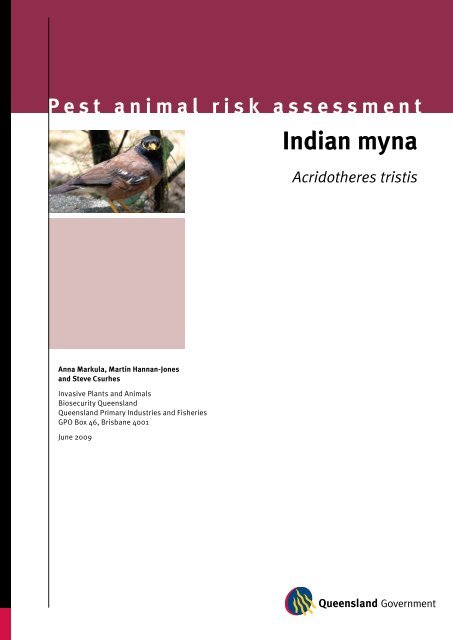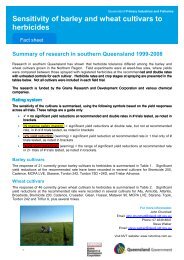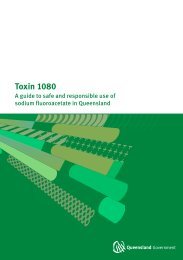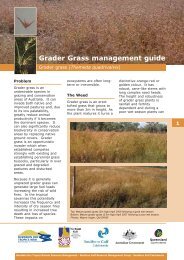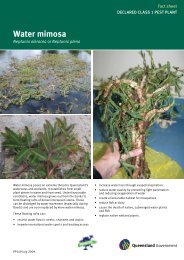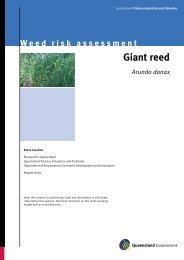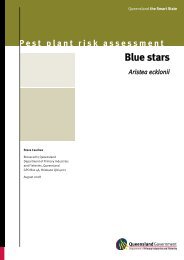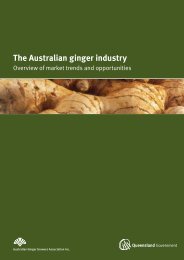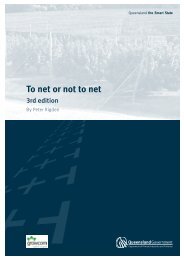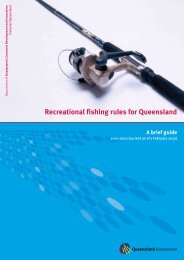Indian myna pest risk assessment - Department of Primary Industries
Indian myna pest risk assessment - Department of Primary Industries
Indian myna pest risk assessment - Department of Primary Industries
Create successful ePaper yourself
Turn your PDF publications into a flip-book with our unique Google optimized e-Paper software.
Pest animal <strong>risk</strong> <strong>assessment</strong><br />
Anna Markula, Martin Hannan-Jones<br />
and Steve Csurhes<br />
Invasive Plants and Animals<br />
Biosecurity Queensland<br />
Queensland <strong>Primary</strong> <strong>Industries</strong> and Fisheries<br />
GPO Box 46, Brisbane 4001<br />
June 2009<br />
<strong>Indian</strong> <strong>myna</strong><br />
Acridotheres tristis
PR09–4413<br />
On 26 March 2009, the <strong>Department</strong> <strong>of</strong> <strong>Primary</strong> <strong>Industries</strong> and Fisheries was amalgamated<br />
with other government departments to form the <strong>Department</strong> <strong>of</strong> Employment, Economic<br />
Development and Innovation.<br />
© The State <strong>of</strong> Queensland, <strong>Department</strong> <strong>of</strong> Employment, Economic Development and<br />
Innovation, 2009.<br />
Except as permitted by the Copyright Act 1968, no part <strong>of</strong> the work may in any form or by any<br />
electronic, mechanical, photocopying, recording, or any other means be reproduced, stored in<br />
a retrieval system or be broadcast or transmitted without the prior written permission <strong>of</strong> the<br />
<strong>Department</strong> <strong>of</strong> Employment, Economic Development and Innovation. The information<br />
contained herein is subject to change without notice. The copyright owner shall not be liable<br />
for technical or other errors or omissions contained herein. The reader/user accepts all <strong>risk</strong>s<br />
and responsibility for losses, damages, costs and other consequences resulting directly or<br />
indirectly from using this information.<br />
Enquiries about reproduction, including downloading or printing the web version, should be<br />
directed to ipcu@dpi.qld.gov.au or telephone +61 7 3225 1398.<br />
Front cover: <strong>Indian</strong> <strong>myna</strong>.(Acridotheres tristis).<br />
Photo: Guillaume Blanchard. Image from Wikimedia Commons under a Creative Commons<br />
Attribution ShareAlike 1.0 Licence.
Introduction<br />
Name and taxonomy<br />
Species: Acridotheres tristis Syn. Acridotheres tristas<br />
Common names: Common <strong>myna</strong>, <strong>Indian</strong> <strong>myna</strong>, <strong>myna</strong>h, talking <strong>myna</strong><br />
Family: Sturnidae<br />
Related species: Acridotheres javanicus (Javan <strong>myna</strong>)<br />
Similar species: Manorina melanocephala (noisy miner)—a slightly larger,<br />
Australian native honeyeater.<br />
Description<br />
<strong>Indian</strong> <strong>myna</strong>s are 23–26 cm long, weigh 82–143 g and have a wing-span <strong>of</strong> 120–142 mm.<br />
Males are slightly larger and heavier than females. Their body is brown, with a glossy black<br />
head, neck and upper breast. In Australia, <strong>Indian</strong> <strong>myna</strong>s are <strong>of</strong>ten confused with the native<br />
noisy miner (Manorina melanocephala). However, <strong>Indian</strong> <strong>myna</strong>s have distinctive white<br />
patches on their wings that are clearly visible in flight. <strong>Indian</strong> <strong>myna</strong>s have bright yellow bills,<br />
eye skin, legs and feet, and the iris <strong>of</strong> the adult bird is a reddish brown. Juveniles are duller in<br />
colour and have brownish heads.
Biology<br />
Life history<br />
Incubation period: 13–14 days<br />
Number <strong>of</strong> eggs: 4–6 (average 4). Greenish blue colour<br />
Breeding interval: Depending on the location, may breed 1–3 times per year<br />
Fledging: 20–32 days (average 25 days)<br />
Sexual maturity: 9–12 months<br />
Sexual activity: Unknown<br />
Life span: Average <strong>of</strong> 4 years in the wild, possibly over 12 years<br />
<strong>Indian</strong> <strong>myna</strong>s are monogamous and pairs use the same territory each year. During courtship,<br />
males display to females.<br />
Nests are cup-shaped and built out <strong>of</strong> dry grass, twigs, leaves, feathers and assorted<br />
rubbish. <strong>Indian</strong> <strong>myna</strong>s build their nests in protected hollows, either in naturally occurring tree<br />
hollows, artificial nesting boxes or in crevices and gaps in buildings, such as under the eaves<br />
<strong>of</strong> houses and in any gaps in walls and ceilings. In Israel, nest sites have been found in palm<br />
trees, woodpecker holes, traffic lights, electricity utility poles, and crevices in buildings<br />
(Holzapfel et al. 2006).<br />
Both parent <strong>myna</strong>s help incubate their eggs, with the female incubating the eggs overnight.<br />
Nestlings are fed for the first ten days exclusively on invertebrates, primarily insects. Males<br />
and females both feed the young, and may continue to feed and protect the young up to three<br />
weeks after fledging. When juvenile <strong>Indian</strong> <strong>myna</strong>s are independent, they form small flocks<br />
and may form breeding pairs from nine months <strong>of</strong> age. The breeding season in Australia<br />
extends from August to March (Animal Diversity Web, 2007; Australian Museum Online,<br />
2003; ISSG, 2006; NSW DPI, undated; Pell & Tidemann, 1997b).<br />
Social organisation<br />
<strong>Indian</strong> <strong>myna</strong>s are social birds, forming loose flocks <strong>of</strong> five or six birds while they forage during<br />
the day. In the evening, all <strong>myna</strong>s within a one kilometer radius (except nesting females and<br />
juveniles) gather in a communal roost, which can number thousands <strong>of</strong> birds. Up to 5000<br />
birds have been recorded in a single roost. However, in Australia, there are usually 40–80<br />
birds per roost. Roosts are usually selected where there is dense foliage and shelter, <strong>of</strong>ten in<br />
large trees, but also in buildings and under bridges. Large roosts are messy and very noisy,<br />
especially at dusk, when the birds chatter loudly.<br />
<strong>Indian</strong> <strong>myna</strong>s maintain territories and defend them aggressively. Each territory tends to cover<br />
a nesting site and a nearby feeding area. Territories can range in size from 117 m² to 2.0 ha<br />
(Pell & Tidemann, 1997b).<br />
P e s t a n i m a l r i s k a s s e s s m e n t : <strong>Indian</strong> <strong>myna</strong> Acridotheres tristis<br />
2
Diet and feeding behaviour<br />
<strong>Indian</strong> <strong>myna</strong>s are generalist, opportunistic omnivores, feeding on a wide variety <strong>of</strong> food,<br />
including invertebrates, bird eggs, small reptiles, food scraps, pet food, fledging birds,<br />
cultivated seedlings, and the ripening fruit and seeds <strong>of</strong> plants such as figs, papaya, dates,<br />
apple, pear, tomato, and cereal crops such as maize, wheat and rice. Their diet is highly<br />
flexible, enabling them to take advantage <strong>of</strong> seasonal, or otherwise temporary, food sources.<br />
For example, at some coastal locations <strong>Indian</strong> <strong>myna</strong>s gather at low tide to feed on worms,<br />
molluscs, crustaceans and other seafood that has been stranded.<br />
<strong>Indian</strong> <strong>myna</strong>s usually scavenge on the ground (for example, around rubbish dumps, pastures,<br />
farmlands, roads), but will also feed in flowering or fruiting trees and bushes. They usually<br />
forage in pairs or small family groups on the ground, or in larger groups in trees and shrubs.<br />
Most feeding occurs close to roosting or nesting sites, usually within 100 m <strong>of</strong> the roost<br />
(Australian Museum Online, 2003; ISSG, 2006; NSW DPI, undated).<br />
Preferred habitat<br />
<strong>Indian</strong> <strong>myna</strong>hs prefer warm to hot climates, being abundant in many tropical, subtropical<br />
and warm temperate areas in Australia and overseas. They are generally absent from areas<br />
where the average minimum temperature <strong>of</strong> the coldest month is less than –0.4˚C. This is<br />
probably due to the effect <strong>of</strong> cold temperatures on hatching success, since invertebrates<br />
(nestling food) are not readily available at very low temperatures (Martin, 1996). One<br />
exception is in New Zealand, where <strong>Indian</strong> <strong>myna</strong>s established a small population near a<br />
piggery shed. The heat and food from the piggery allowed them to survive in a region that<br />
would otherwise have been too cold.<br />
In Australia, <strong>Indian</strong> <strong>myna</strong>s prefer open habitats where the original native tree cover has been<br />
cleared or otherwise fragmented by human activity. Prime habitat includes open parks and<br />
gardens associated with towns and cities as well as any cleared agricultural areas, especially<br />
open grasslands, cultivated paddocks, cane fields and plantations. As tree cover increases,<br />
<strong>Indian</strong> <strong>myna</strong>s tend to become less abundant and are absent from dense forests and closed<br />
rainforest. The degree to which <strong>Indian</strong> <strong>myna</strong>s can invade and persist in eucalypt forest and<br />
woodland seems to depend on tree cover and may vary from one region to the next. For<br />
example, in (disturbed) open eucalypt woodland near Brisbane, the authors observed a<br />
single <strong>Indian</strong> <strong>myna</strong> being attacked and driven away by up to 20 native noisy miners, grey<br />
butcherbirds and magpies. Such behaviour from aggressive, locally native birds might<br />
explain why <strong>Indian</strong> <strong>myna</strong>s are absent from some areas <strong>of</strong> eucalypt woodland. In other parts <strong>of</strong><br />
Australia, however—such as near Canberra—<strong>Indian</strong> <strong>myna</strong>s can invade and persist in eucalypt<br />
woodland. For example, Pell & Tidemann (1997b) found that the while <strong>Indian</strong> <strong>myna</strong>s were<br />
generally more abundant in ‘edge habitats’ <strong>of</strong> urban nature reserves, compared with the<br />
interior <strong>of</strong> woodland habitats, they still managed to utilise a range <strong>of</strong> forest habitat types<br />
during the breeding season.<br />
In their native range, <strong>Indian</strong> <strong>myna</strong>s evolved in open woodland habitats (Pell & Tidemann,<br />
1997b).<br />
P e s t a n i m a l r i s k a s s e s s m e n t : <strong>Indian</strong> <strong>myna</strong> Acridotheres tristis<br />
3
Outside their native range, <strong>Indian</strong> <strong>myna</strong>s have naturalised in a variety <strong>of</strong> habitat types, but<br />
generally in open areas, where natural tree cover has been damaged or removed. In Hawaii,<br />
<strong>Indian</strong> <strong>myna</strong>s can be found at elevations from sea level to 2300 m (Englund & Preston, 2000).<br />
On the Comoro Islands (between Africa and Madagascar), <strong>Indian</strong> <strong>myna</strong>s exist in open<br />
environments, such as degraded forests and tree plantations, and only occasionally enter<br />
more intact forests. The presence <strong>of</strong> <strong>Indian</strong> <strong>myna</strong>s on these islands is considered a good<br />
indicator <strong>of</strong> habitat degradation (Sontag & Louette, 2007). In the Middle East, <strong>Indian</strong> <strong>myna</strong>s<br />
prefer areas undergoing major land use change, such as large irrigated grass lawns<br />
interspersed with trees and artificial structures such as street and traffic lights. They are<br />
currently spreading in Middle Eastern countries that can afford large-scale landscaping,<br />
where water is used to create artificial tropical and subtropical habitats in areas that are<br />
otherwise arid or semi-arid (Holzapfel et al. 2006).<br />
Predators and diseases<br />
In the Middle East and parts <strong>of</strong> Asia, the eggs and chicks <strong>of</strong> <strong>Indian</strong> <strong>myna</strong>s are occasionally<br />
taken by <strong>Indian</strong> house crows, cats and Javan mongooses. In some <strong>of</strong> the Pacific Islands,<br />
humans are known to eat these birds (Animal Diversity Web, 2007).<br />
While raptors prey on <strong>Indian</strong> <strong>myna</strong>s in some countries, a dietary study <strong>of</strong> peregrine falcons<br />
(Falco peregrinus) and Australian Hobbies (Falco longipennis) in Australia found that <strong>Indian</strong><br />
<strong>myna</strong>s were not part <strong>of</strong> the raptors’ diet, despite being optimal prey size (Olsen et al. 2008).<br />
<strong>Indian</strong> <strong>myna</strong>s are susceptible to haemosiderosis and haemochromatosis (‘iron overload’)<br />
(Mete et al. 2001).<br />
<strong>Indian</strong> <strong>myna</strong>s can carry diseases that may not affect them directly. For example, in Australia,<br />
they carry avian malaria (Plasmodium and Haemoproteus spp.) that originally came from<br />
<strong>Indian</strong> founding stock (Ishtiaq et al. 2006). In Hawaii, the introduction <strong>of</strong> avian malaria by<br />
<strong>Indian</strong> <strong>myna</strong>s has had a significant impact on native birds, perhaps contributing to the<br />
extinction <strong>of</strong> some species. <strong>Indian</strong> <strong>myna</strong>s maintain the disease at a high level, but do not<br />
seem to be affected by it (Caughley & Sinclair, 1994).<br />
Distribution and abundance overseas<br />
<strong>Indian</strong> <strong>myna</strong>s are native to a large area <strong>of</strong> the Middle East, India and Asia, including<br />
Afghanistan, Bangladesh, Bhutan, Cambodia, China, Egypt, India, Islamic Republic <strong>of</strong> Iran,<br />
Kazakhstan, Lao People’s Democratic Republic, Lebanon, Malaysia, Myanmar, Nepal,<br />
Pakistan, Sri Lanka, Tajikistan, Thailand, Turkmenistan, Uzbekistan and Vietnam.<br />
They have become naturalised in Australia, Brunei, Darussalam, Comoros, Cook Islands,<br />
Fiji, French Polynesia, Hong Kong, Indonesia, Israel, Kiribati, Kuwait, Madagascar, Maldives,<br />
Mauritius, Mayotte, New Caledonia, New Zealand, Oman, Qatar, Reunion, Saint Helena,<br />
Samoa, Seychelles, Singapore, Solomon Islands, South Africa, Spain, Tonga, Turkey, United<br />
States, Vanuatu, Wallis and Futuna.<br />
Today, <strong>Indian</strong> <strong>myna</strong>s have a vast range, with an estimated global extent <strong>of</strong><br />
1 000 000–10 000 000 km² (BirdLife International, 2004; ISSG 2006).<br />
In some countries, including the United States, Hawaii and Australia, <strong>Indian</strong> <strong>myna</strong>s are kept<br />
as pets, due to their intelligence and ability to mimic human speech (Blue Mountains Bird<br />
Watching, undated).<br />
P e s t a n i m a l r i s k a s s e s s m e n t : <strong>Indian</strong> <strong>myna</strong> Acridotheres tristis<br />
4
Figure 1. Worldwide distribution <strong>of</strong> Acridotheres tristis. (Source: Peacock et al. 2007).<br />
Distribution and abundance in Australia<br />
<strong>Indian</strong> <strong>myna</strong>s are distributed throughout eastern Australia from western Victoria in the south,<br />
to Cairns in the north (Figure 2). They are most abundant in suburban and agricultural regions<br />
<strong>of</strong> south-eastern Queensland and in northern areas near Cairns and Townsville. In Cairns<br />
there are up to 1000 birds per square kilometre (Australian Rainforest Foundation, 2007).<br />
They have also been recently spotted in Perth, Adelaide and Tasmania (Australian Museum<br />
Online, 2003; <strong>Department</strong> <strong>of</strong> Agriculture and Food Western Australia, 2008; Stoddart &<br />
Handke, 2008).<br />
There were several releases <strong>of</strong> <strong>Indian</strong> <strong>myna</strong>s in Australia between 1862 and 1872. It is not<br />
known why they were originally introduced. The first release was in Melbourne where 42 birds<br />
were released in 1863. In 1883, some <strong>of</strong> these <strong>myna</strong>s were taken to sugarcane-growing areas<br />
in northern Queensland, in the belief that they would help control insect <strong>pest</strong>s on cane,<br />
particularly locusts and cane beetles. By the 1950s and 1960s, <strong>Indian</strong> <strong>myna</strong>s were well<br />
established in many eastern metropolitan areas, and continued to spread throughout many<br />
regions (Long, 1981).<br />
Species conservation status<br />
P e s t a n i m a l r i s k a s s e s s m e n t : <strong>Indian</strong> <strong>myna</strong> Acridotheres tristis<br />
5<br />
Figure 2. Distribution map <strong>of</strong> Acridotheres<br />
tristis in Australia. (Source: Birdata, 2007).<br />
IUCN Red List—Acridotheres tristis was listed as a Species <strong>of</strong> Least Concern in 2004.
Threat to human health and safety<br />
There have been reports <strong>of</strong> <strong>Indian</strong> <strong>myna</strong>s attacking people, swooping in a similar manner to<br />
magpies (Answers.com, 2008). These attacks can cause serious injury, with one man<br />
receiving a lacerated left eye after being struck (Young, 2000). Large roosts inside buildings<br />
can spread disease (such as salmonellosis, Newcastle disease and Avian influenza) to people<br />
and can cause dermatitis and asthma because <strong>of</strong> the mites they carry (Brisbane City Council,<br />
undated; Thomas, 2004). The materials used to build nests can also be a fire hazard<br />
(Canberra <strong>Indian</strong> Myna Action Group Inc., undated).<br />
History as a <strong>pest</strong><br />
<strong>Indian</strong> <strong>myna</strong>s are listed among 100 <strong>of</strong> the world’s worst invaders by IUCN/SCC Invasive<br />
Species Specialist Group (ISSG, 2006).<br />
<strong>Indian</strong> <strong>myna</strong>s are regarded as <strong>pest</strong>s in many countries, on every continent except South<br />
America and Antarctica. They rank as one <strong>of</strong> the most abundant birds on a number <strong>of</strong> islands<br />
in the <strong>Indian</strong>, Atlantic, and Pacific oceans.<br />
Over their naturalised range, <strong>Indian</strong> <strong>myna</strong>s are considered to pose a threat to natural<br />
biodiversity, by competing with native animals for food and nesting resources. In addition,<br />
they cause some crop damage and have various impacts on the public, due mainly to their<br />
noisy roosts and habit <strong>of</strong> nesting in gaps in walls and eaves (Peacock et al. 2007).<br />
In south-east Asia, <strong>Indian</strong> <strong>myna</strong>s started to spread in the early 1900s. This may have been<br />
assisted by an expansion in agriculture and its associated habitat fragmentation, and/or<br />
deliberate release <strong>of</strong> birds. <strong>Indian</strong> <strong>myna</strong>s are now a common bird around towns and villages.<br />
However, they are generally not considered a problem in these regions and are <strong>of</strong>ten referred<br />
to ‘farmer’s friends’ due to their habit <strong>of</strong> eating insect <strong>pest</strong>s (Long, 1981; Tidemann, 2007).<br />
In Singapore, <strong>Indian</strong> <strong>myna</strong> numbers have increased rapidly. The large communal roosts are a<br />
major nuisance due to the noise, pollution from droppings, the presence <strong>of</strong> fungal growth in<br />
faeces that may cause respiratory problems in people and damage to trees and buildings<br />
from the weight <strong>of</strong> roosts (Yap et al. 2002).<br />
From the mid-1700s and throughout the 1800s, there were many deliberate introductions <strong>of</strong><br />
<strong>Indian</strong> <strong>myna</strong>s to islands in the <strong>Indian</strong>, Atlantic and Pacific oceans, usually to control insect<br />
<strong>pest</strong>s such as locusts, wasps (Tahiti), and army worms (Hawaii). <strong>Indian</strong> <strong>myna</strong>s are now a<br />
serious problem in many <strong>of</strong> these places. Some examples <strong>of</strong> impacts are:<br />
• in the Seychelles, <strong>Indian</strong> <strong>myna</strong>s have adverse effects on the breeding success <strong>of</strong> the<br />
endangered magpie robin (Copsychus sechellarum) (Komdeur, 1996)<br />
• in Tahiti, <strong>Indian</strong> <strong>myna</strong>s have adverse effects on breeding success <strong>of</strong> the critically<br />
endangered Tahiti flycatcher (Pomarea nigra), possibly due to nest predation and also<br />
territorial aggression (Blanvillain et al. 2003)<br />
• in Fiji, <strong>Indian</strong> <strong>myna</strong>s compete with native seabirds for food, carry owl flies, lice,<br />
threadworms and roundworms that may affect native birds, predate upon eggs and young<br />
<strong>of</strong> terns (Sterna spp.) and noddies (Anous spp.) (ISSG, 2006)<br />
• in Hawaii, <strong>Indian</strong> <strong>myna</strong>s disperse invasive plants such as Lantana camara (ISSG, 2006) and<br />
carry avian malaria (Caughley & Sinclair, 1994)<br />
• in New Zealand, <strong>Indian</strong> <strong>myna</strong>s cause production losses by feeding on grains and stock<br />
foods. In some regions, grain crop losses <strong>of</strong> up to 80% have been reported (Northland<br />
Regional Council, undated)<br />
P e s t a n i m a l r i s k a s s e s s m e n t : <strong>Indian</strong> <strong>myna</strong> Acridotheres tristis<br />
6
• in Florida, <strong>Indian</strong> <strong>myna</strong>s attack indigenous purple martins (Progne subis) (Florida Fish and<br />
Wildlife Conservation Commission, undated)<br />
• in Israel, <strong>Indian</strong> <strong>myna</strong>s have shown aggressive behaviour towards Syrian woodpeckers<br />
(Dendrocopos syriacus) (Holzapfel et al. 2006).<br />
Potential distribution and impact in Queensland<br />
Climatically, <strong>Indian</strong> <strong>myna</strong>s are well adapted to most <strong>of</strong> Queensland (Figure 3). As such, they<br />
have the potential to expand their range and become more abundant in a variety <strong>of</strong> open<br />
habitats, including parks, gardens, suburbs/towns, agricultural areas and certain types <strong>of</strong><br />
eucalypt woodland. They have a clear preference for areas that have been heavily disturbed<br />
by human activities and are not expected to invade rainforests, or other dense forest types.<br />
Ongoing clearing <strong>of</strong> tree cover for agriculture and urban development will undoubtedly create<br />
ideal habitat for <strong>Indian</strong> <strong>myna</strong>s.<br />
P e s t a n i m a l r i s k a s s e s s m e n t : <strong>Indian</strong> <strong>myna</strong> Acridotheres tristis<br />
7<br />
Figure 3. Potential distribution <strong>of</strong> <strong>Indian</strong><br />
<strong>myna</strong>s (Acridotheres tristis) in Australia, as<br />
predicted by ‘PC CLIMATE’ (climate-matching<br />
computer s<strong>of</strong>tware). (Orange indicates areas<br />
where climate is most suitable, decreasing to<br />
yellow, green, light blue, dark blue, purple,<br />
with grey as the least suitable areas).<br />
To develop this model, all climatic points<br />
across the species’ introduced and native<br />
range with an altitude <strong>of</strong> less than 2000 m<br />
were used (source information: Peacock et al.<br />
2007).<br />
Where there is favourable habitat, <strong>Indian</strong> <strong>myna</strong>s can be expected to have the following range<br />
<strong>of</strong> impacts:<br />
• reduce breeding success <strong>of</strong> certain native parrot species. <strong>Indian</strong> <strong>myna</strong>s compete<br />
aggressively for nesting hollows and can evict native parrots from nest boxes or tree<br />
hollows and even kill eggs and chicks. A pair <strong>of</strong> <strong>myna</strong>s can build nests in multiple nesting<br />
hollows without using every nest. Such behaviour probably deters other species and<br />
maintains a large breeding territory (Pell & Tidemann, 1997a)<br />
• compete for tree hollows with other native wildlife such as possums and gliders. <strong>Indian</strong><br />
<strong>myna</strong>s can kill small mammals and remove sugar gliders from tree hollows (NSW DPI,<br />
undated; Perry, 2008)<br />
• act as a potential reservoir for diseases <strong>of</strong> native birds such as avian malaria (Caughley &<br />
Sinclair, 1994)<br />
• damage fruit, vegetable, and cereal crops<br />
• spread certain weeds such as Lantana camara (DPI NSW, undated) and fireweed (Senecio<br />
madagascariensis) (Cunich, 2006)<br />
• generate noise complaints in suburban areas, wherever there are large communal roosts<br />
• cause dermatitis, allergies, and asthma in people by nesting in the ro<strong>of</strong>s <strong>of</strong> houses<br />
(Brisbane City Council, 2007). Nests built in ro<strong>of</strong>s <strong>of</strong> houses are also a possible fire <strong>risk</strong><br />
(Canberra <strong>Indian</strong> Myna Action Group Inc., undated).<br />
Some native species that may be adversely affected by <strong>Indian</strong> <strong>myna</strong>s include, but are not<br />
limited to, the species listed on the following page.
Threatened bird species<br />
Barking owl (Ninox connivens)<br />
Brown treecreeper (Climacteris picumnus)<br />
Coxen’s double-eyed fig parrot (Cyclopsitta diophthalma coxeni)<br />
Flesh-footed shearwater (Puffinus carneipes)<br />
Glossy black cockatoo (Calyptorhynchus lathami)<br />
Hooded plover (Thinornis rubricollis)<br />
Little tern (Sterna albifrons)<br />
Masked owl (Tyto novaehollandiae)<br />
Powerful owl (Ninox strenua)<br />
Regent parrot (Polytelis anthopeplus)<br />
Sooty owl (Tyto tenebricosa)<br />
Sooty tern (Sterna fuscata)<br />
Superb parrot (Polytelis swainsonii)<br />
Turquoise parrot (Neophema pulchella)<br />
White tern (Gygis alba)<br />
Threatened mammal species<br />
Beccari’s freetail bat (Mormopterus beccarii)<br />
Brush-tailed phascogale (Phascogale tapoatafa)<br />
Eastern false pipistrelle (Falsistrellus tasmaniensis)<br />
Eastern long-eared bat (Nyctophilus bifax)<br />
Eastern pygmy-possum (Cercartetus nanus)<br />
Greater broad-nosed bat (Scoteanax rueppellii)<br />
Hoary wattled bat (Chalinolobus nigrogriseus)<br />
Large-footed myotis (Myotis adversus)<br />
Squirrel glider (Petaurus norfolcensis)<br />
Yellow-bellied glider (Petaurus australis)<br />
Yellow-bellied sheathtail bat (Saccolaimus flaviventris)<br />
P e s t a n i m a l r i s k a s s e s s m e n t : <strong>Indian</strong> <strong>myna</strong> Acridotheres tristis<br />
8
Non-threatened species<br />
Common brushtail possum (Trichosurus vulpecula)<br />
Crimson rosella (Platycercus elegans)<br />
Dollarbird (Eurystomus orientalis)<br />
Eastern rosella (Platycercus eximius)<br />
Laughing kookaburra (Dacelo novaeguineae)<br />
Red-rumped parrot (Psephotus haematonotus)<br />
Sugar glider (Petaurus breviceps)<br />
White-striped freetail-bat (Tadarida australis)<br />
(<strong>Department</strong> <strong>of</strong> Environment and Heritage, 2005; NSW DPI, undated; NSW Government,<br />
undated; Pell & Tidemann, 1997a; Wetlandcare Australia, undated).<br />
Legal status <strong>of</strong> <strong>Indian</strong> <strong>myna</strong>s in Australia and Queensland<br />
In Western Australia, the Agriculture and Related Resources Protection Act 1976 prohibits<br />
entry and keeping <strong>of</strong> <strong>Indian</strong> <strong>myna</strong>s, and also lists the species as a target for eradication<br />
(<strong>Department</strong> <strong>of</strong> Agriculture and Food, Western Australia, 2006).<br />
<strong>Indian</strong> <strong>myna</strong>s are restricted in Tasmania under the Nature Conservation Act 2002.<br />
In the Northern Territory, <strong>Indian</strong> <strong>myna</strong>s are listed as ‘Prohibited entrants’ under the Territory<br />
Parks and Wildlife Conservation Act 2007 (Northern Territory <strong>of</strong> Australia, 2007).<br />
In Queensland, <strong>Indian</strong> <strong>myna</strong>s are not listed as a ‘declared <strong>pest</strong>’ under the Land Protection<br />
(Pest and Stock Route Management) Act 2002; nor are they listed as ‘Prohibited Wildlife’<br />
under the Nature Conservation (Wildlife) Regulation, 2006.<br />
P e s t a n i m a l r i s k a s s e s s m e n t : <strong>Indian</strong> <strong>myna</strong> Acridotheres tristis<br />
9
Numerical <strong>risk</strong> <strong>assessment</strong><br />
Using a numerical <strong>risk</strong> <strong>assessment</strong> system developed by Bomford (2006), <strong>Indian</strong> <strong>myna</strong>s in<br />
Queensland were assessed as an ‘extreme’ threat species (See Appendix 1).<br />
P e s t a n i m a l r i s k a s s e s s m e n t : <strong>Indian</strong> <strong>myna</strong> Acridotheres tristis<br />
10
References<br />
Animal Diversity Web (2007). Acridotheres tristis—common <strong>myna</strong>.<br />
http://animaldiversity.ummz.umich.edu/site/accounts/information/Acridotheres_tristis.html<br />
Answers.com (2008). Common Myna.<br />
www.answers.com/topic/common-<strong>myna</strong><br />
Australian Museum Online (2003). Common Myna.<br />
www.amonline.net.au/factSheets/common_<strong>myna</strong>.htm<br />
Australian Rainforest Foundation (2007). Researching the Effectiveness <strong>of</strong> Myna Bird<br />
(acridotheres tristis) Roost Trapping as a Control Method.<br />
www.arf.net.au/newsandmedia/reports/Myna_Report_ARF_2007.pdf<br />
Birdata (2007). Atlas Distribution Maps—Common Myna.<br />
www.birdata.com.au/maps.vm#<br />
BirdLife International (2004). Acridotheres tristis.<br />
www.iucnredlist.org/search/details.php/51915/all<br />
Blanvillain, C, Salducci, JM, Tutururai & G, Maeura, M (2003). ‘Impact <strong>of</strong> introduced birds on<br />
the recovery <strong>of</strong> the Tahiti Flycatcher (Pomarea nigra), a critically endangered forest bird <strong>of</strong><br />
Tahiti’, Biological Conservation, 109: 197–205.<br />
Blue Mountains Bird Watching (undated). Common Myna.<br />
www.bluemountains.net/birds/bird.asp?bird_id=208<br />
Bomford, M (2006). Risk <strong>assessment</strong> for the establishment <strong>of</strong> exotic vertebrates in Australia:<br />
recalibration and refinement <strong>of</strong> models. Australian Government, Bureau <strong>of</strong> Rural Sciences.<br />
Brisbane City Council (2007). Brisbane Invasive Species Management Plan.<br />
www.brisbane.qld.gov.au/bccwr/environment/documents/invasive_species_mgmt_plan_b.pdf<br />
Brisbane City Council (undated). Common Myna.<br />
www.brisbane.qld.gov.au/BCC:BASE::pc=PC_2287<br />
Canberra <strong>Indian</strong> Myna Action Group Inc. (undated). An Obnoxious Invader that’s a Threat to<br />
our Wildlife.<br />
www.indian<strong>myna</strong>action.org.au/<br />
Caughley, G & Sinclair, ARE (1994). Wildlife Ecology and Management. Blackwell Publishing.<br />
Cunich, G (2006). Australia’s Unnoticed Environmental Disaster.<br />
www.indian<strong>myna</strong>eradication.com/Reports/Environmental%20Disaster%20Report.pdf<br />
<strong>Department</strong> <strong>of</strong> Agriculture and Food, Western Australia (2006). Agriculture and Related<br />
Resources Protection Act 1976.<br />
http://svapp1.estation.com.au/swcc/reports/PESTS_200610_DECLAREDANIMALS%5B1%5D.pdf<br />
<strong>Department</strong> <strong>of</strong> Agriculture and Food, Western Australia (2008). Animal Pest Alert—Common<br />
Myna. www.agric.wa.gov.au/content/pw/vp/bird/CommonMyna_NHT.pdf<br />
<strong>Department</strong> <strong>of</strong> Environment and Heritage (2005). Superb Parrot—Polytelis swainsonii.<br />
www.environment.gov.au/biodiversity/threatened/publications/tsd05superb-parrot.html<br />
P e s t a n i m a l r i s k a s s e s s m e n t : <strong>Indian</strong> <strong>myna</strong> Acridotheres tristis<br />
11
Englund, RA & Preston, DJ (2000). Avian Species Assessment for the Kuhio Highway,<br />
Manoa Stream Ford Crossing Project.<br />
http://hbs.bishopmuseum.org/pdf/hbs2000-005.pdf<br />
Florida Fish and Wildlife Conservation Commission (undated). Common Myna.<br />
http://myfwc.com/nonnatives/exotics/SpeciesNumberResults.asp?SPPNO=95<br />
Griffin, AS (2008). ‘Social learning in <strong>Indian</strong> <strong>myna</strong>hs, Acridotheres tristis: the role <strong>of</strong> distress<br />
calls’, Animal Behaviour, 75: 79–89.<br />
Holzapfel, C, Levin, N, Hatz<strong>of</strong>e O & Kark, S (2006). ‘Colonisation <strong>of</strong> the Middle East by the<br />
invasive Common Myna Acridotheres tristis L., with special reference to Israel’, Sandgrouse,<br />
28(1): 44–51.<br />
Ishtiaq, F, Beadell, JS, Baker, AJ, Rahmani, AR, Jhala, YV & Fleischer, RC (2006). ‘Prevalence<br />
and evolutionary relationships <strong>of</strong> haematozoan parasites in native versus introduced<br />
populations <strong>of</strong> common <strong>myna</strong> Acridotheres tristis’, Proceedings <strong>of</strong> the Royal Society B,<br />
273: 587–594.<br />
ISSG (2006). Acridotheres tristis (bird).<br />
www.issg.org/database/species/ecology.asp?fr=1&si=108<br />
Komdeur, J (1996). ‘Breeding <strong>of</strong> the Seychelles Magpie Robin Copsychus sechellarum and<br />
implications for its conservation’, Ibis, 138: 485–498.<br />
Long, JL (1981). Introduced Birds <strong>of</strong> the World. A. H. & A.W. Reed Pty Ltd.<br />
Martin, WK (1996). ‘The Current and Potential Distribution <strong>of</strong> the Common Myna<br />
Acridotheres tristis in Australia’, Emu, 96: 166–173.<br />
Mete, A, Dorrestein, GM, Marx, JJM, Lemmens, AG & Beyen, AC (2001). ‘A comparative study <strong>of</strong><br />
iron retention in <strong>myna</strong>hs, doves and rats’, Avian Pathology, 30: 479–486.<br />
New South Wales Government (undated). Threatened and <strong>pest</strong> animals <strong>of</strong> Greater<br />
Southern Sydney.<br />
www.environment.nsw.gov.au/resources/threatenedspecies/07227tpagssch7pt1.pdf<br />
Northern Territory <strong>of</strong> Australia (2007). Territory Parks and Wildlife Conservation Act.<br />
www.austlii.edu.au/au/legis/nt/consol_act/tpawca451.txt/cgibin/download.cgi/download/<br />
au/legis/nt/consol_act/tpawca451.rtf<br />
Northland Regional Council (undated). Pest Management Strategy for Magpie and Myna.<br />
www.nrc.govt.nz/upload/2724/Magpie%20and%20Myna.pdf<br />
NSW DPI (undated). Common <strong>myna</strong> (Acridotheres tristis).<br />
www.dpi.nsw.gov.au/__data/assets/pdf_file/0007/237238/common-<strong>myna</strong>.pdf<br />
Olsen, J, Fuentes, E, Bird, DM, Rose, AB & Judge, D (2008). ‘Dietary Shifts Based Upon Prey<br />
Availability in Peregrine Falcons and Australian Hobbies Breeding Near Canberra, Australia’,<br />
Journal <strong>of</strong> Raptor Research, 42(2): 125–137.<br />
Peacock, DS, van Rensburg, BJ & Robertson, MP (2007). ‘The distribution and spread <strong>of</strong> the<br />
invasive alien common <strong>myna</strong>, Acridotheres tristis L. (Aves: Sturnidae), in southern Africa’,<br />
South African Journal <strong>of</strong> Science, 103: 465–473.<br />
Pell, AS & Tidemann, CR (1997a). ‘The Impact <strong>of</strong> Two Exotic Hollow-nesting Birds on Two Native<br />
Parrots in Savannah and Woodland in Eastern Australia’, Biological Conservation, 79:145–153.<br />
P e s t a n i m a l r i s k a s s e s s m e n t : <strong>Indian</strong> <strong>myna</strong> Acridotheres tristis<br />
12
Pell, AS & Tidemann, CR (1997b) ‘The Ecology <strong>of</strong> the Common Myna in Urban Nature Reserves<br />
in the Australian Capital Territory’, Emu, 97: 141–149.<br />
Perry, A (2008) Native bird threat a <strong>myna</strong> matter.<br />
http://hawkesbury.yourguide.com.au/news/local/news/news-features/native-bird-threat-a<strong>myna</strong>-matter/526921.aspx<br />
Sontag Jr, WA & Louette, M (2007) ‘The potential <strong>of</strong> particular starlings (Sturnidae) as<br />
indicators <strong>of</strong> habitat change’, Journal <strong>of</strong> Ornithology, 148 (Suppl 2): S261–S267.<br />
Stoddart, P & Handke, B (2008) Tackling <strong>Indian</strong> Mynas—the cane toad on wings.<br />
http://majura.org/wp-content/uploads/2008/05/report-tackling-indian-<strong>myna</strong>-the-cane-toadon-wings.doc<br />
Sunshine Coast Regional Council (2006) Maroochy Pest Management Plan 2006–2010.<br />
www.maroochy.qld.gov.au/environment/documents/<strong>pest</strong>_management_plan.pdf<br />
Tasmania Legislation (2008) Nature Conservation Act 2002.<br />
www.thelaw.tas.gov.au/tocview/index.w3p;cond=;doc_id=63%2B%2B2002%2BAT@EN%2B<br />
20080906000000;histon=;prompt=;rec=-1;term=<br />
Tidemann, C (2007) Common <strong>Indian</strong> Myna.<br />
http://fennerschool-associated.anu.edu.au/<strong>myna</strong>/identification.html<br />
Thomas, A (2004) Scribbly Gum—Myna Fightback.<br />
www.abc.net.au/science/articles/2004/04/08/2044900.htm?site=science/scribblygum<br />
Townsville City Council (2004) Townsville Local Government Area Pest Management Plan<br />
2004–2008.<br />
http://previous.townsville.qld.gov.au/wwwdocs/health/TPL_Pest%20Management%20<br />
Plan/11%20Pest%20Animals%20for%20Prevention,%20Eradication%20&%20Containment.pdf<br />
Wetlandcare Australia (undated) <strong>Indian</strong> Myna Control Project.<br />
www.wetlandcare.com.au/docs/info_bulletins_projects/<strong>Indian</strong>_Myna_info_bulletin_3106.pdf<br />
Wikipedia (2008) Common Myna.<br />
http://en.wikipedia.org/wiki/Common_Myna<br />
Yap, CAM, Sodhi, NS & Brook, BW (2002) ‘Roost Characteristics <strong>of</strong> Invasive Mynas in<br />
Singapore’, The Journal <strong>of</strong> Wildlife Management, 66(4): 1118–1127.<br />
Young, A (2000) ‘Corneal laceration with total but isolated aniridia caused by a pecking<br />
injury’, Journal <strong>of</strong> Cataract and Refractive Surgery, 26(9): 1419–1421.<br />
P e s t a n i m a l r i s k a s s e s s m e n t : <strong>Indian</strong> <strong>myna</strong> Acridotheres tristis<br />
13
Appendix 1<br />
Using the Bomford (2006) system, <strong>Indian</strong> <strong>myna</strong>s in Queensland were considered an extreme<br />
threat species.<br />
Species: Acridotheres tristis (<strong>Indian</strong> <strong>myna</strong>)<br />
Date <strong>of</strong> <strong>assessment</strong>: 16 September 2008<br />
Literature search type and date: See references<br />
Factor Score<br />
A1. Risk to people from individual escapees<br />
(0–2)<br />
A2. Risk to public safety from individual<br />
captive animals (0–2)<br />
Stage A. Risk posed by captive or released<br />
individuals = Sum <strong>of</strong> A1 to 2. (0–4)<br />
B1. Climate match (1–6) 4<br />
B2. Exotic population established overseas<br />
(0–4)<br />
B3. Taxonomic class (0–1) 0 Bird.<br />
P e s t a n i m a l r i s k a s s e s s m e n t : <strong>Indian</strong> <strong>myna</strong> Acridotheres tristis<br />
14<br />
1<br />
0<br />
<strong>Indian</strong> <strong>myna</strong>s are territorial and will<br />
swoop and attack people, and may<br />
cause injuries that require medical<br />
attention.<br />
Apart from someone entering an<br />
enclosure or otherwise being in reach <strong>of</strong><br />
a captive animal, there is nil or low <strong>risk</strong><br />
to public safety.<br />
1 Moderately dangerous<br />
4<br />
High climate match in Australia.<br />
CMS = 1224.<br />
Exotic populations are established<br />
on islands larger than 50 000 square<br />
kilometres and also on continents.<br />
B4. Migratory (0–1) 1 Non-migratory in its native range.<br />
B5. Diet (0–1) 1<br />
B6. Habitat (0–1) 1<br />
B7. Overseas range size (0–2) 1<br />
B. Probability escaped or released individuals<br />
will establish a free-living population = Sum<br />
<strong>of</strong> B 1 to 7. (1–16)<br />
C1. Taxonomic group (0–4) 2<br />
C2. Overseas range size including current<br />
and past 1000 years, natural and introduced<br />
range (0–2)<br />
Generalist diet <strong>of</strong> invertebrates, bird<br />
eggs, small reptiles, food scraps, pet<br />
food, fledging sparrows, cultivated<br />
seedlings, and the ripening fruit and<br />
seeds <strong>of</strong> plants such as figs, papaya,<br />
dates, apple, pear, tomato, and cereal<br />
crops.<br />
<strong>Indian</strong> <strong>myna</strong>s live in human-disturbed<br />
habitats.<br />
Overseas range size <strong>of</strong> 1–10 million<br />
square kilometres.<br />
12 Serious establishment <strong>risk</strong><br />
Bird in taxa that is particularly prone to<br />
causing agricultural damage.<br />
1 1–10 million square kilometres.<br />
C3. Diet and feeding (0–3) 0 Not a mammal.
C4. Competition with native fauna for tree<br />
hollows (0–2)<br />
C5. Overseas environmental <strong>pest</strong> status (0–3) 3<br />
C6. Climate match to areas with susceptible<br />
native species or communities (0–5)<br />
C7. Overseas primary production <strong>pest</strong> status<br />
(0–3)<br />
C8. Climate match to susceptible primary<br />
production (0–5)<br />
C9. Spread disease (1–2) 2<br />
C10. Harm to property (0–3) 3<br />
C11. Harm to people (0–5) 3<br />
C. Probability an exotic species would<br />
become a <strong>pest</strong> (for birds, mammals, reptiles<br />
and amphibians) = Sum <strong>of</strong> C 1 to 11. (1–37)<br />
A. Risk to public safety posed by captive or<br />
released individuals<br />
A = 0 = not dangerous; A = 1 = moderately<br />
dangerous; A ≥ 2 = highly dangerous<br />
B. Risk <strong>of</strong> establishing a wild population<br />
For birds and mammals: B < 6 = low<br />
establishment <strong>risk</strong>; B = 7–11 = moderate<br />
establishment <strong>risk</strong>; B = 12–13 = serious<br />
establishment <strong>risk</strong>; B > 14 = extreme<br />
establishment <strong>risk</strong><br />
For reptiles and amphibians: B < 3 = low<br />
establishment <strong>risk</strong>; B = 3–4 = moderate<br />
establishment <strong>risk</strong>; B = 5–6 = high<br />
establishment <strong>risk</strong>; B > 6 = extreme<br />
establishment <strong>risk</strong><br />
C. Risk <strong>of</strong> becoming a <strong>pest</strong> following<br />
establishmen<br />
C < 9 = low <strong>pest</strong> <strong>risk</strong>; C = 9–14 = moderate<br />
<strong>pest</strong> <strong>risk</strong>; C = 15–19 = serious <strong>pest</strong> <strong>risk</strong>;<br />
C > 19 = extreme <strong>pest</strong> <strong>risk</strong><br />
P e s t a n i m a l r i s k a s s e s s m e n t : <strong>Indian</strong> <strong>myna</strong> Acridotheres tristis<br />
15<br />
2 Can nest or shelter in tree hollows.<br />
5<br />
3<br />
Major environmental <strong>pest</strong> throughout<br />
established range.<br />
The species has more than 20 grid<br />
squares within the highest two climate<br />
match classes, and has more than 100<br />
grid squares within the four highest<br />
climate match classes, that overlap the<br />
distribution <strong>of</strong> any susceptible native<br />
species or communities.<br />
Major <strong>pest</strong> <strong>of</strong> primary production in<br />
Australia and New Zealand.<br />
5 Score = 290 see Table 1.<br />
All birds and mammals (likely or<br />
unknown effect on native species and on<br />
livestock and other domestic animals).<br />
Annual value <strong>of</strong> property damage<br />
estimated at least $50 million.<br />
Social nuisance—annoyance moderate<br />
or severe and few people at <strong>risk</strong> (see A1).<br />
29 Extreme <strong>pest</strong> <strong>risk</strong><br />
1 Moderately dangerous<br />
12 Serious establishment <strong>risk</strong><br />
29 Extreme <strong>pest</strong> <strong>risk</strong><br />
VPC threat category Extreme
P e s t a n i m a l r i s k a s s e s s m e n t : <strong>Indian</strong> <strong>myna</strong> Acridotheres tristis<br />
16
PR09–4413


